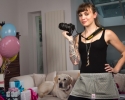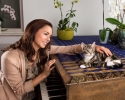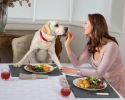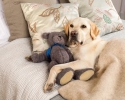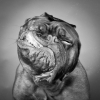Blog
Our pets are more photographed than our partners. Nikon research reveals Brits’ love for their animal companions. (01.09.2012)
Pets have reaffirmed their family status after research has revealed 82 per cent of pet owners in the United Kingdom consider them as part of their immediate family and take twice as many photographs of our furry friends than our partners.
Whilst immediate family was the most popular subject in the UK when it comes to photography (49 per cent), pets are putting partners firmly in third place with just one in five (19 per cent) naming their other half as the subject they take most photographs of, compared to 45 per cent saying their pet. When looking for company, pets are again a worthy choice. Thirty-six per cent of pet owners in the UK would prefer to spend time with their pet over their parents (19 per cent) and siblings (11 per cent) making them the third favourite companion after partners (60 per cent) and children (44 per cent).
This is according to European research across 12 countries from Nikon to celebrate the launch of its new entry-level D-SLR camera, the Nikon D3200. It’s the perfect camera for easily capturing the everyday moments of family life with beautiful pictures and cinematic quality movies. Putting them firmly in the family line up, the vast majority of owners say they include their pets in everyday activities. Sixty per cent talk to them as if they are human; 34 per cent let their pets share their bed; and 32 per cent share their food with them. Eighteen per cent of owners leave the radio or television on to keep their pet company when they go out and 13 per cent even confide or share their secrets with them. Pets are not left out of important occasions either as 39 per cent of owners buy their faithful companion presents, 19 per cent celebrate their birthday and 16 per cent are taken on holiday.
Pets on show
People in the UK are also keen to show off their pets with mobile devices being the most popular place to store photos of them – 45 per cent have saved an image there – while 32 per cent have used a photo as their computer wallpaper and 33 per cent have posted photos of their pets on social networks.
Commenting on the research, Carli Davidson, international award winning pet and animal photographer, said: “This research shows just how important a role pets play in family life, so it is understandable that we want to capture and share their precious moments, just as we would a child, sibling or partner – if not more so. That said, it can be difficult to get the right shot. You cannot control animals the same way as humans – they are often moving targets, and conveying their personality in a still image is challenging. That’s where the D3200 can really make a difference – whether you want photographs or movies – because it is very easy to use, even if you haven’t picked up a D-SLR before. It also has features to capture the moment exactly as you intended, even if you have low light or your dog is racing around the park! There are certain things you can do to improve your photography but having a great camera is a good place to start.”
Marina Gurevich, Product Manager for Nikon Europe, comments: “Pets are clearly an important aspect of family life so it’s only natural that we want to take beautiful photography and movies that capture their personalities. The D3200 is the perfect camera for those looking to get into D-SLR photography to get high quality pictures of all the family action – you can either let the camera choose the settings with features such as Scene Auto Selector, which applies the most relevant setting, or learn how to get that shot for yourself using the Guide Mode. Your pet will never look so good!”
The research also highlighted that the UK is a nation of cat lovers with over half (54 per cent) owning one compared to 49 per cent having a dog.
Carli Davidson has provided her tips for great pet photography:
Make pets love the camera. Let them sniff it and lick it. Hold it below them so that the camera becomes less intimidating. Reward them with treats when they approach it and show interest, but remember to protect your lens from slobber with a filter.
Make sure you feel positive. Animals are intuitive, they communicate with expressions and body language so they instinctively know if you are not in the mood to have fun, and they respond accordingly. Go into the shoot ready to have a good time, and they will want to play along.
Try to get their attention. Hold a squeaker or a toy over your lens to get them to look into the camera. Be warned, some pets will just bolt for the toy. Also, try not to over squeak, pets are smart and will lose interest quickly if they realise they are not rewarded for responding to the noise.
Use trained behaviours and tricks. This is particularly relevant for dogs, but does your pet know how to roll over? If so, take a photo of them lying on their back. Practice their ‘stay’ while you get portraits of them. They will be focusing on you for a reward and for direction so you should be able to get some good eye contact. Also, get to know which words and sounds your pet responds to. Tapping their food bowl usually gets a reaction, and words and phrases like ‘treat’, ‘car ride’, ‘do you want to go for a walk?’ or even just their name can generate some cute head tilts and excited expressions.
Try using props to capture different expressions. If you are photographing a dog outside, grab a long stick and use one hand to play with your pet while shooting with the other. You will get some pretty funny faces from them trying to grab it. If you are shooting a cat, remember how much they concentrate on toys. You could try dangling a feather on a string out of frame, or throwing a ball for them to chase – this can generate some hilarious cat poses if you take the photo at just the right moment.

